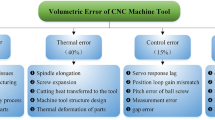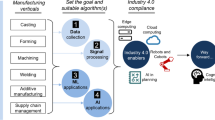Abstract
Inappropriate machining conditions such as cutting forces cause tool failures, poor surface quality and worst of all machine breakdowns. This may be avoided by using optimal machining parameters, e.g. feed-rate, and continuing to monitor it throughout the machining process. To optimize feed-rate, we propose a system that consists of an optimisation module, a process control module and a knowledge based evaluation module. STEP-NC is the underlying data model for optimisation. Given the nominal powers, the cutting force can be estimated based on the higher-level production information such as workpiece properties, tool materials and geometries, and machine capabilities. The main function of the Process Control module is process monitoring and control. The output is the desired actual feed-rate. Finally, the actual feed-rate is recorded and evaluated in the Knowledge Based Evaluation module.
Similar content being viewed by others
Abbreviations
- a min :
-
Minimum depth of cut (mm)
- a s :
-
Average depth of cut (mm)
- a max :
-
Maximum depth of cut (mm)
- a allowable :
-
Depth of cut permitted by machine (mm)
- a t :
-
Total depth of cut (mm)
- b w :
-
Workpiece width or cutting width (mm)
- c :
-
Constant
- d si :
-
Different types of face-milling
- d s1 :
-
Full-face milling type
- d s2 :
-
Unidirectional part-face type
- d s3 :
-
Bilateral part-face type
- e :
-
Distance of overlapping (mm)
- η m :
-
Mechanical efficiency
- F mt :
-
Total mean tangential milling force (N)
- \({f_s^{\min}}\) :
-
Minimum feed-rate (mm/min)
- f s :
-
Feed-rate (mm/min)
- \({f_s^{\max}}\) :
-
Maximum feed-rate (mm/min)
- \({f_{s1}^{\rm opt}}\) :
-
Optimum feed-rate for time-critical (mm/min)
- \({f_{s2}^{\rm opt}}\) :
-
Optimum feed-rate for quality-critical (mm/min)
- f z :
-
Feed per tooth (mm/r)
- f mz :
-
Allowable feed mechanism (mm/min)
- h m(χ) :
-
The mean chips thickness (mm)
- k s :
-
Specific cutting resistance (N/mm2)
- l m :
-
Total travel at whole features path (mm)
- N m :
-
Main drive motor power (kW)
- N mc :
-
Predicted motor power (kW)
- N c :
-
Cutting power (kW)
- n :
-
Milling cutter rotational speed (rpm)
- R t :
-
Peak-to-valley surface roughness (μm)
- R a :
-
Arithmetic surface roughness (μm)
- \({\overline R_a}\) :
-
Arithmetic average surface roughness (μm)
- r t :
-
Tool nose radius (mm)
- t :
-
Chips thickness (mm)
- t m :
-
Machining time (min)
- \({t_{s1}^{\rm opt}}\) :
-
Optimum machining time for time-critical (min)
- \({\varphi_1}\) :
-
Entrance angle (deg)
- \({\varphi_2}\) :
-
Exit angle (deg)
- \({\overline \varphi_c }\) :
-
Contact angle in horizontal milling (radians)
- V c :
-
Cutting speed (m/min)
- χ:
-
Setting angle (deg)
- Z c :
-
Number of cutting teeth
References
Aggarwal A., Singh H. (2005) Optimisation of machining techniques: A retrospective and literature review. Sadhana 30(6): 699–711
Boud F., Gindy N. N. Z. (2008) Application of multi-sensors for monitoring tool/workpiece condition in broaching. International Journal of Computer Integrated Manufacturing 21(6): 715–729
Byrne G., Dornfeld D., Inasaki I., Ketteler G., Konig W., Teti R. (1995) Tool condition monitoring (TCM)—The status of research and industrial application (keynote papers). Annals of the CIRP 44(2): 541–567
Chang T. C., Chen J. C. (1999) Fuzzy nets based on-line cutting power recognition in milling operations. International Journal of Advanced Manufacturing Technology 15: 231–237
Chen J. C., Chen W. L. (1999) A tool breakage detection system using an accelerometer sensor. Journal of Intelligent Manufacturing 10(2): 187–197
Chen J. C. (2000) An effective fuzzy-nets training scheme for monitoring tool breakage. Journal of Intelligent Manufacturing 11(1): 85–101
Desforges X., Habbadi A., Geneste L., Soler F. (2004) Distributed machining control and monitoring using smart sensors/actuators. Journal of Intelligent Manufacturing 15(1): 39–53
El-Hofy H. (2007) Fundamentals of machining processes: Conventional and non-conventional processes. Taylor and Francis, New York
Feng C. X. J., Wang X. (2002) Development of empirical models for surface roughness prediction in finish turning. International Journal of Advanced Manufacturing Technology 20: 348–356
Ghani J. A., Choudhury I. A., Hassan H. H. (2004) Application of Taguchi method in the optimisation of end milling parameters. Journal of Materials Processing Technology 145: 84–92
Henriques E. (2006) Towards the integration of process and production planning: An optimisation model for cutting parameters. International Journal of Advanced Manufacturing Technology 28: 117–128
Ismail F., Kubica E. G. (1995) Active suppression of chatter in peripheral milling: Part I, A statistical indicator to evaluate the spindle speed modulation method. International Journal Advanced Manufacturing Technology 10: 299–310
ISO 10303-11. (1994). Industrial automation systems and integration—product data representation and exchange-part 11: Description methods: The EXPRESS language reference manual.
ISO 10303-21. (1994). Industrial automation systems and integration—product data representation and exchange-part 21: Implementation methods: Clear text encoding of the exchange structure.
ISO 10303-238. (2003). Industrial automation systems and integration—product data representation and exchange-part 238: Application protocols: Application interpreted model for computerized numerical controllers.
ISO 13030-224. (2001). Industrial automation systems and integration—product data representation and exchange-part 224: Application protocol: Mechanical product definition for process plans using machining features.
ISO 14649-10. (2003). Industrial automation systems and integration physical device control-data model for computerized numerical controllers-part 10: General process data, ISO TC 184/SC 1, 23 May 2003.
ISO 14649-11. (2003). Industrial automation systems and integration physical device control-data model for computerized numerical controllers-part 11: Process data for milling, ISO TC 184/SC 1, 23 May 2003.
ISO 14649-111. (2001). Data model for computerized numerical controllers: part 111—tools for milling.
Kim S.-J., Lee H.-U., Cho D.-W. (2006) Feedrate scheduling for indexable end milling process based on an improved cutting force model. International Journal of Machine Tools and Manufacture 46(12–13): 1589–1597
Kramer, T. R., Proctor, F. M., Xu, X., & Michaloski, J. L. (2006). Run-time interpretation of STEP-NC: Implementation and performance. International Journal of Computer Integrated Manufacturing, 19(6), 495–507.
Krimpenis A., Vosniakos G.-C. (2009) Rough milling optimisation for parts with sculptured surfaces using genetic algorithm in a Stackelberg game. Journal of Intelligent Manufacturing 20: 447–461
Kumar S., Nassehi A., Newman T. S., Allen R. D., Tiwari M. K. (2007) Process control in CNC manufacturing for discrete components: A STEP-NC compliant framework. Robotics and Computer-Integrated Manufacturing 23(6): 667–676
Lamikiz A., Lopezde Lacalle L. N., Sanchez J. A., Bravo U. (2005) Cutting force integration at the CAM stage in the high-speed milling of complex surfaces. International Journal of Computer Integrated Manufacturing 18(7): 586–600
Lee H.-U., Cho D.-W. (2007) Development of a reference cutting force model for rough milling feedrate scheduling using FEM analysis. International Journal of Machine Tools and Manufacture 47(1): 158–167
Li Z. Z., Zhang Z. H., Zheng L. (2004) Feedrate optimisation for variant milling process based on cutting force prediction. International Journal of Advanced Manufacturing Technology 24(7–8): 541–552
Liang M., Yeap T., Hermansyah A., Rahmati S. (2003) Fuzzy control of spindle torque for industrial CNC machining. International Journal of Machine Tools and Manufacture 43: 1497–1508
Lim E. E. M., Menq C.-H. (1997) Integrated for precision machining of complex surfaces. Part 1: Cutting-path and federate optimisation. International Journal of Machine Tools and Manufacture 37(1): 61–75
Malakooti B. B., Zhou Y. Q., Tandler E. C. (1995) In-process regressions and adaptive multicriteria neural networks for monitoring and supervising machining operations. Journal of Intelligent Manufacturing 6(1): 53–66
Öktem, H., Erzurumlu, T., Çöl, M. (2006). A study of the Taguchi optimisation method for surface roughness in finish milling of mold surfaces. International Journal of Advanced Manufacturing Technology, 28, 694–700.
Proctor, F. M., Kremer, T. R., & John, L. M. (1997). Canonical machining commands, Intelligent Systems Division National Institute of Standards and Technology Administration, US, Department of Commerce Gaithersburg, Maryland 20899.
Rubio E. M., Teti R. (2009) Cutting parameters analysis for the development of a milling process monitoring system based on audible energy sound. Journal of Intelligent Manufacturing 20: 43–54
Saglam H., Unuvar A. (2003) Tool condition monitoring in milling based on cutting force by neural network. International Journal of Production Research 41(7): 1519–1532
Satishkumar S., Asokan P., Kumanan S. (2006) Optimisation of depth of cut in multi-pass turning using nontraditional optimisation technique. International Journal of Advanced Manufacturing Technology 29: 230–238
Sencer B., Altintas Y., Croft E. (2008) Feed optimisation for five-axis CNC machine tools with drive constraints. International Journal of Machine Tools and Manufacture 48(7–8): 733–745
Smithey D. W., Kapoor Shiv G., DeVor Richard E. (2001) A new mechanistic model for predicting worn tool cutting forces. Machining Science and Technology 5(1): 23–42
Soliman E., Ismail F. (1997) Chatter suppression by adaptive speed modulation. International Journal of Machine Tools and Manufacture 37(3): 355–369
STEP-NC. (2000). Newsletter. Issue 3, http://www.stepnc.org/.
Wang H., Xu X., Tedford J. D. (2007) An adaptable CNC system based on STEP-NC and function blocks. International Journal of Production Research 45(17): 3809–3829
Wosnik M., Kramer C., Selig A., Klemm P. (2006) Enabling feedback of process data by use of STEP-NC. International Journal of Computer Integrated Manufacturing 19(6): 559–569
Xu L. (2009) STEP-NC in support of machining process optimisation. In: Xu X., Nee A. Y. C. (eds) Advanced design and manufacturing based on STEP. Springer, New York
Xu X. (2009) Integrating Advanced Computer-Aided Design, Manufacturing, and Numerical Control: Principles and Implementations 1st Ed.. Information Science Reference IGI global, New York
Xu X., Klemm P., Proctor F., Suh S. H (2006) STEP-compliant process planning and manufacturing. International Journal of Computer Integrated Manufacturing 19(6): 491–494
Zhang J. Y., Liang S. Y., Yao Y., Chen J. M., Huang J. L. (2006) Evolutionary optimisation of machining processes. International Journal of Manufacturing 17: 203–215
Zhang C. (2009) Off-line feed-rate optimisation based on simulation of cutting force. Key Engineering Material 407–408: 408–411
Zhao Y. F., Xu X., Xie S. (2008) STEP-NC enabled on-line inspection in support of closed-loop machining. Robotics and Computer-Integrated Manufacturing 24(2): 200–216
Author information
Authors and Affiliations
Corresponding author
Rights and permissions
About this article
Cite this article
Ridwan, F., Xu, X. & Liu, G. A framework for machining optimisation based on STEP-NC. J Intell Manuf 23, 423–441 (2012). https://doi.org/10.1007/s10845-010-0380-9
Received:
Accepted:
Published:
Issue Date:
DOI: https://doi.org/10.1007/s10845-010-0380-9




